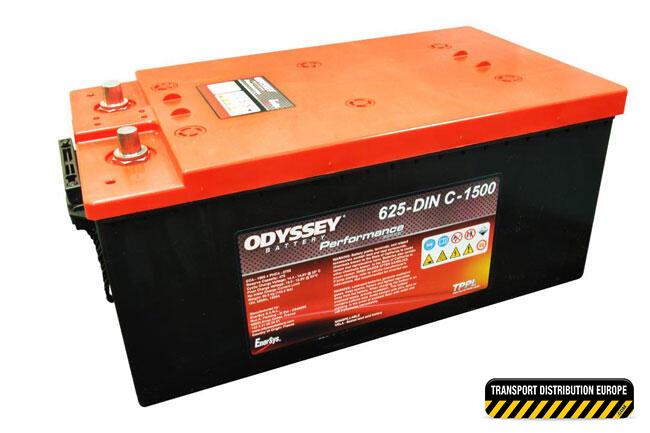EnerSys introduces ODYSSEY Performance Series batteries to meet the challenges faced by large commercial vehicle users
Mar 12, 2019
EnerSys has launched its ODYSSEY Performance Series batteries for buses, trucks and other large commercial vehicles. Optimised to meet the high load demands of the modern automotive vehicle sector, the batteries offer a solution to fleet owners and operators who are facing a sharp rise in battery-related vehicle breakdowns.

Advanced Thin Plate Pure Lead (TPPL) technology enables unmatched battery performance improvements, providing unrivalled usable capacity, strength and life – to reliably power even the most demanding vehicles – along with an outstanding reduction in total cost of ownership.
Phil Arrowsmith, Director Specialty Market EMEA at EnerSys, commented: ‘The ODYSSEY Performance Series battery range is what modern transport and service vehicles have been waiting for. Tried and tested in the heavy-duty vehicle market for more than five years, these superior batteries harness the power of TPPL battery technology to deliver massive starting and endurance ability.’
Available in standard footprints for European heavy-duty vehicles, ODYSSEY Performance Series batteries comply with DIN B and DIN C size standards for Europe and the widely recognised – though no longer formally accepted – 629 and 625 references for the UK.
Today’s vehicle and driver systems are demanding ever-higher levels of performance, beyond anything conventional batteries were ever designed for. Existing batteries are therefore increasingly unable to handle vehicles’ growing electrical loads.
A typical battery challenge is to support a ‘hotel load’ without the need to restart the engine, while retaining enough reserve power to reliably start the engine again the following morning – and to repeat this without fail throughout the battery’s operating life.
ODYSSEY Performance Series batteries offer a total solution through their use of Thin Plate Pure Lead (TPPL) chemistry. This offers a true technological alternative to the lead-calcium flooded or newer lead-calcium AGM types currently in popular use. TPPL’s advantages are proven: an industry-standard test showed that the 625-DIN C-1500 model could support a typical load for over 14 hours and then start an engine. When compared with a competing product’s 6.5 hours’ endurance, this shows TPPL batteries to be 100 per cent stronger for longer.
TPPL batteries can also be discharged to a much higher depth compared to conventional types, while still providing a successful engine start on demand. This results in fuel savings and a reduced carbon footprint, as the battery can be used for an extended period before the engine is started. This energy density provides an impressive cold crank amps (CCA) rating of up to 1500A for DIN C and 1300A for the DIN B product.
Vehicle maintenance costs are slashed, as the TPPL batteries provide the optimal stable voltages required by today’s electro-mechanical systems for longer than comparable battery types. This cuts component stress, with fewer starts and lower currents. Maintenance time and costs are further reduced by eliminating the need to top up with water.
Improved battery performance is also good for the environment. By running at a 30 per cent lower state of charge than alternative batteries, anti-idling efficiency is massively improved. For instance, the batteries’ ability to recharge quickly helps to reduce engine running costs and fuel use, while making more power available. Their ability to support fast charging is a game-changer for delivery trucks.
The batteries offer great operational benefits along with power performance improvements. They have a high vibration tolerance, rated to EN 50342-1 V3 standard, reducing the risk of premature failure. Additionally, they have an extreme temperature tolerance of -40°C to +50°C. Their virtually maintenance-free, non-spillable design enables more flexible mounting, unrestricted transportation and safer handling.
If required as back-up stock, the batteries can be stored on an open circuit, with no load across the terminals, without recharging for up to 24 months at 20°C. This outperforms an alternative with six months’ storage life. As the service life also far exceeds that of comparable types, the batteries reduce TCO while optimising performance.
TPPL’s thin positive and negative electrode plates – just 1mm thick, compared to 3mm for conventional batteries – allows many more electrodes in a given space, increasing battery capacity and boosting power density. This increased surface area shrinks the space requirement for the same power density as AGM by about 30 per cent.
TPPL uses 99.99 per cent pure lead, together with very high-purity sulphuric acid. The chemical behaviour of the batteries is significantly more resilient than AGM’s lead-calcium alloy, with the grain structure of the pure lead plates making them far less susceptible to corrosion. This enables a lower depth of discharge and also provides for an extended service life compared to conventional lead-acid technologies.
